Yesterday, we debuted the first in our series on H1-B visas with an examination of what the H1-B visa is and what the process involved to get one is like. Today, we’ll delve deeper to better understand why it’s become such a hot topic right now as well as look at data from a range of sources on U.S. employer willingness to sponsor international MBAs who require legal documentation such as the H1-B.
Why Are H1-B Visas Such a Big Deal Right Now?
International students attending business school in the United States with hopes of remaining there to work after graduation is not a new phenomenon. According to the 2017 mba.com Prospective Students Report released by the Graduate Management Admission Council last month, almost three in five prospective business school students (59 percent) intend to apply to programs outside their country of residence, up from 44 percent in 2009. While the primary motivator for candidates seeking study opportunities outside their home country is to receive a higher-quality education (63 percent of respondents), those looking to increase their chance of securing international employment represent a close second (58 percent of respondents). Further, 34 percent of candidates who prefer to study outside their country of citizenship intend to seek employment in the country where they prefer to attend school. In this most recent GMAC applicant survey, 58 percent of international applicants named the United States as where they hoped to attend business school.
International students most often come to the U.S. to study on what is called an F-1 visa. The F-1 is a nonimmigrant visa for those wishing to study in the U.S. at a university or college, high school, private elementary school, seminary, conservatory, language training program, or other academic institution. As part of the F-1 program, when these international students complete their course of study, they can apply for what is called Optional Practical Training (OPT), a period that allows the graduate to work or intern for any employer—or for themselves—for a period of 12 months in the field in which they have been studying. Students can apply for OPT anywhere between 90 days before their course completion date and 60 days after their course completion date. A job offer or employer sponsorship is not required for OPT.
MBA students who are hoping to remain in the U.S. for work after graduation will seek employment with a company that is willing to sponsor them on the H1-B visa. The employer—on the student’s behalf—will apply to have the student entered in the H1-B visa lottery by the early April deadline. The results of the lottery come out between mid-May and July. If a graduating student is awarded an H1-B visa through the lottery, he or she is then granted work authorization for a period of three years, with the opportunity to extend for an additional three-year period. Those who do not get the H1-B through the lottery can remain in the U.S. on OPT for up to 12 months and try again for the H1-B the following April.
But given the role of immigration in the current political climate, Trump’s campaign promises to “hire American,” and an array of proposed changes to H1-B visa policy, it’s unclear whether it will become harder or easier for MBAs to obtain the legal documentation necessary to remain in the U.S. to work, which has companies reacting in a variety of ways—and prospective MBA applicants, current students, grads, and business schools needing to make educated guesses about how the future may unfold—while also making contingency plans.
Which Employers Sponsor MBAs Who Need H1-Bs?
The challenges inherent with hiring international talent is, unfortunately, proving great enough to make some U.S. employers opt out entirely. According to GMAC’s 2016 Corporate Recruiters Survey, released last June, 51 percent of companies hiring MBAs in the United States said they did not plan to employ international graduates. The limited supply of visas was cited as among the top reasons these companies are refusing to hire foreign-born MBAs, together with higher costs and time-consuming paperwork and documentation associated with international hires, language barriers, and additional time required in the hiring process. Some companies also cited security clearances and cultural differences as additional disincentives for hiring international MBAs.
Still, 24 percent of U.S. employers told GMAC they were open to hiring international MBAs, and 25 percent reported specific plans to hire international candidates who require legal documentation such as H1-B visas.
In terms of industries, the GMAC survey found that companies in consulting (33 percent of respondents), manufacturing (29 percent), technology (27 percent), and finance (26 percent) sectors were more likely than others to have plans to hire international candidates requiring legal documentation—though note that these figures are for overall international hiring in all regions, not the United States specifically.
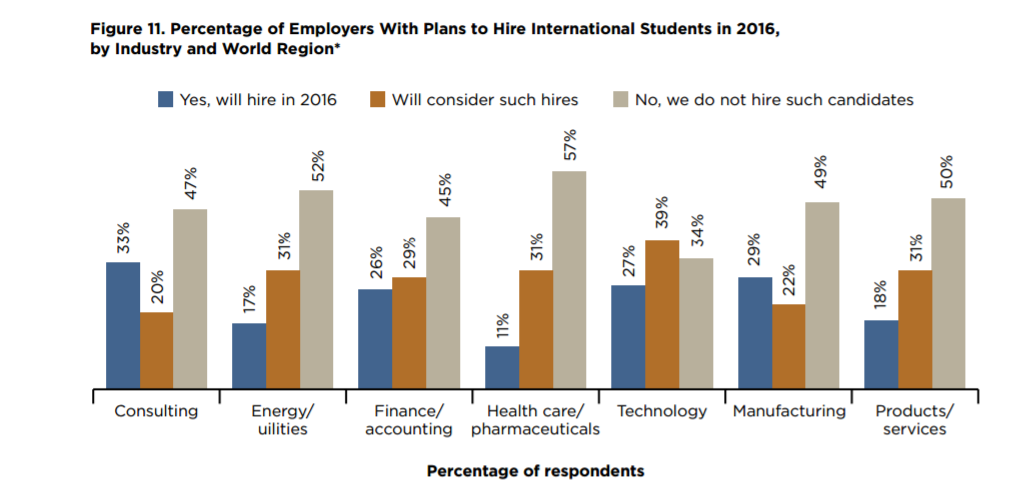
Note: GMAC’s 2017 Corporate Recruiters Survey will be released next week, and Clear Admit will highlight any changes in U.S. companies’ hiring plans as soon as that data is made public.
MBA Student-Reported Data Sheds Light on Employer Sponsorship Trends
Transparent Career (formerly Transparent MBA)—a startup founded by two University of Chicago Booth School of Business MBA students—provides even more specific data on which U.S. industries and firms are hiring international students.
“It began as a request from one of the schools,” Kevin Marvinac, Transparent Career co-founder and chief operating officer, tells Clear Admit. “The way this info gets gathered right now is basically a cohort of schools shares an Excel document about how many students from different schools are getting H1-B visa sponsorship from which companies. It’s this massive, disgusting Excel file that gets furtively handed to students if they know to ask for it.”
Marvinac says he can understand why employers wouldn’t want the information to be readily available all the time—especially with how in flux H1-B visa protocol seems to be. But schools and students need access to the data to be able to more strategically plan the career paths that students can confidently pursue.
In an effort to democratize the data more, Transparent Career over the past year and a half or so has begun surveying its 14,000 registered users specifically about H1-B visa status as part of its information-gathering process. While the sample size is still small, Marvinac estimates that the firm currently touches about 45 to 50 percent of MBAs studying at top-50 full-time programs in the United States, which provides a pretty good lens into the current state of hiring.
By diving into this MBA-specific visa sponsorship database, Transparent Career was able to highlight not only which industries, but also which individual companies are hiring international students, as well as the types of jobs that are more likely to merit H1-B visa sponsorship. First, looking at industries, the Transparent Career data show that tech and consulting are the two largest industries sponsoring MBAs for H1-B visas, representing 28.10 and 21.9 percent of H1-B sponsorships respectively. (This supports data as reported by companies themselves to GMAC.) “Tech companies are well-known for sponsoring talented non-U.S. citizens, and are quite vocally opposed to current anti-immigration sentiments,” Transparent Career notes in a blog post revealing this data.
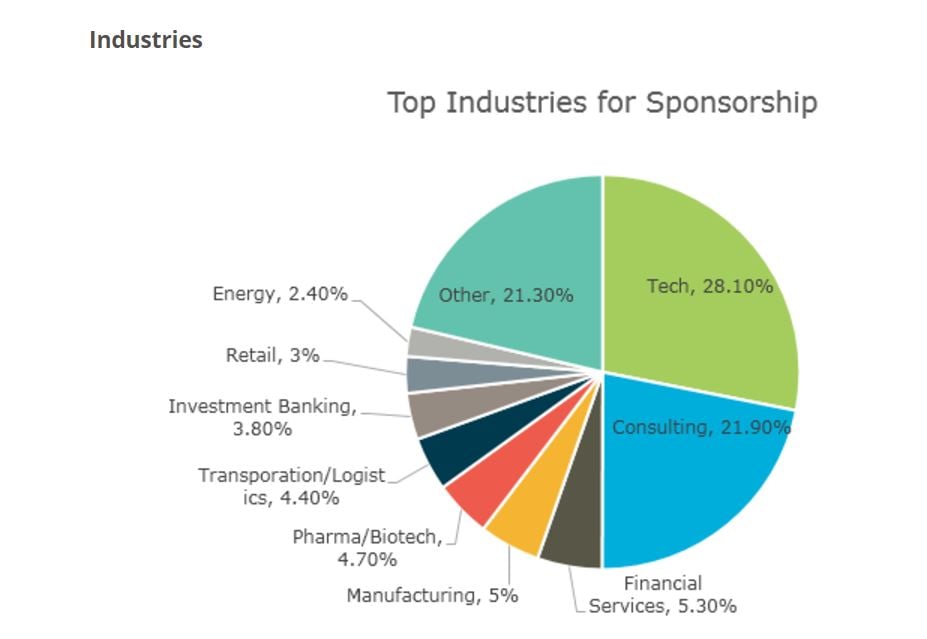
In terms of functions, the lion’s share of sponsorship goes to individuals in consulting roles—22.2 percent, followed by “other” at 22.2 percent, and product management at 11.2 percent. ”Note that despite Tech as an industry offering a plethora of sponsorships, the functions sponsored within the industry tend to be pretty evenly dispersed between Product Management, Operations, General Management, Strategy, and others,” Transparent Career points out.
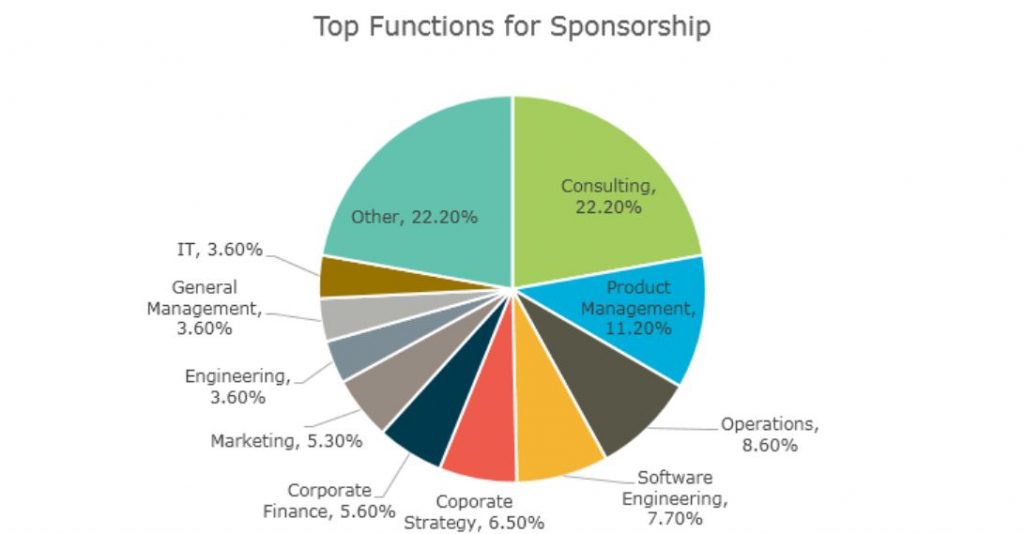
Transparent Career data also reveal that MBAs receiving H1-B sponsorship tend to be clustered in large cities—most along the East and West Coasts (Chicago being an exception). Marvinac notes that robust hiring among certain tech employers contributes to the strong showing in cities like Seattle, San Francisco, and San Jose.
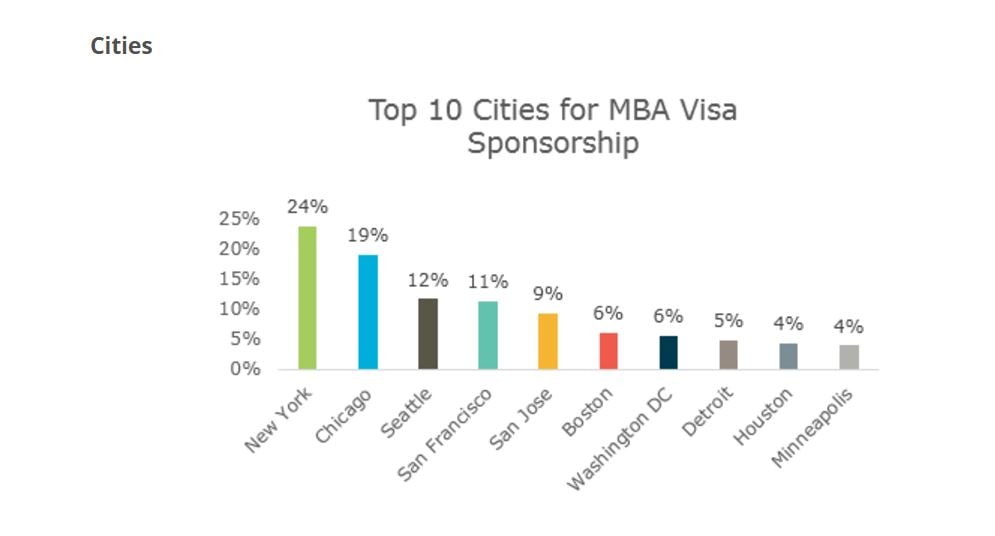
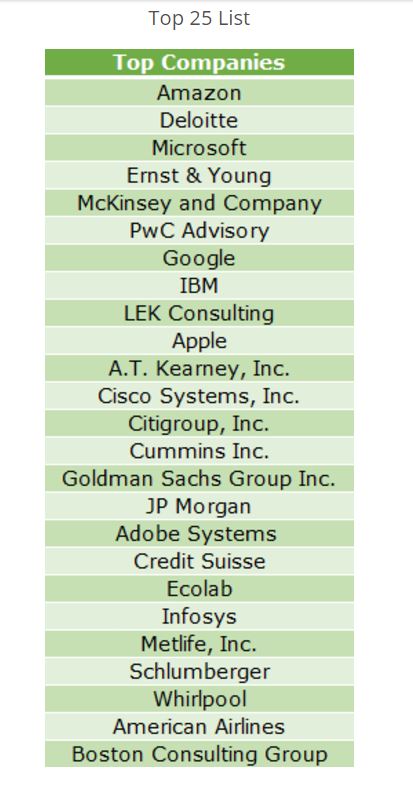
Top Firms Sponsoring MBAs for H1-B Visas
Diving into the data at the company level also revealed for Transparent Career a Top 25 list of companies sponsoring international students on H1-B visas. “It was simply a matter of tallying the highest numbers,” reads the company’s blog post. “We made sure each data point was of an MBA graduate, and that the job they were reporting was for a position immediately following graduation.”
Amazon hired 18 Transparent Career users, more than any other company. Next up was Microsoft, with 13, followed by Deloitte, with 10. Rounding out the top 10 were Ernst & Young, McKinsey, PwC/Strategy &, Google, IBM, LEK (a consulting firm started by former Bain partners), and Apple.
Finally, Transparent Career provided a full list of the top 25 firms, as shown at right.
Next Up: Some Firms Offer International Students Creative Contingency Plans if H1-B Doesn’t Come Through





